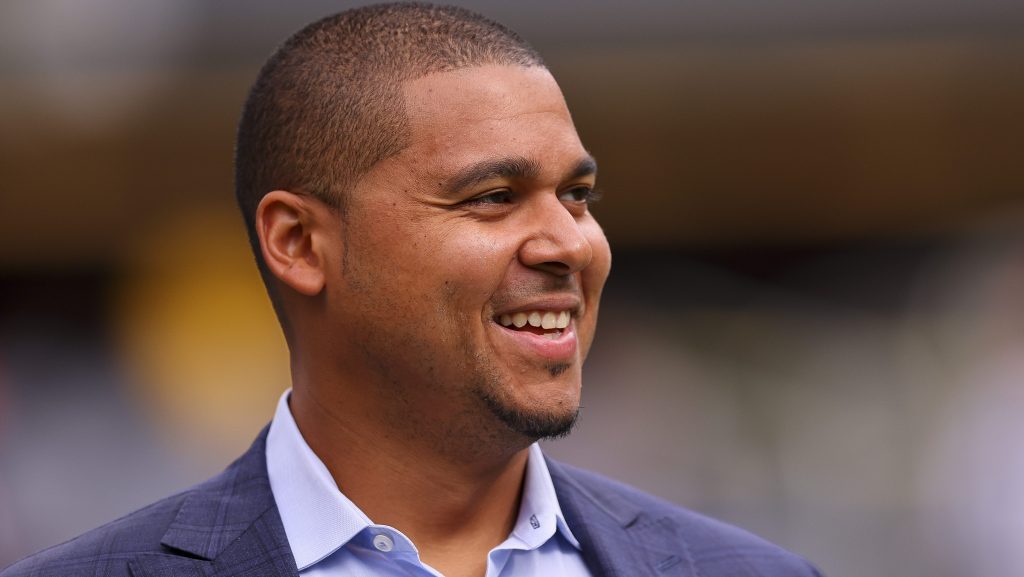The Chicago Bears might be hoping that one of the top three wide receivers in the 2024 NFL draft class falls into their hands with the No. 9 overall pick. If they have strong feelings about receivers outside the trio, though, trading back further into the first round could bring them the most rewards.
Pro Football Focus’ Arjun Menon recently created a draft prediction based on betting odds for the sports analytics website. This involved decisions about what position a team is most likely to draft first or when a prospect is projected to be drafted.
For the Bears, Menon made a interesting move. With Rome Odunze available at No. 9, he predicted that the Bears would trade down with the Arizona Cardinals — who had already traded down from No. 3 in his mock draft — for the selections 11 and 99. Then, with the 11th pick, the Bears got their desired player, LSU’s Brian Thomas Jr.
“Step 1: Draft Caleb Williams; Step 2: Surround him with the best situation possible,” Menon wrote. “Brian Thomas Jr. helps achieve the latter for Chicago. While DJ Moore and the recently acquired Keenan Allen are already one of the league’s best wide receiver duos, the depth behind them is very spotty. Thomas instantly fixes that and gives Chicago a future WR2 if they can’t come to terms on an extension with Allen.”
Brian Thomas Jr. is an NFL-Ready Receiving Talent
Some Bears fans are sure to shake their heads at the suggestion that Chicago could pass on Odunze only to draft Thomas two picks later. Odunze has been mentioned in the same breath as Marvin Harrison Jr. and Malik Nabers — Thomas’ LSU teammate — throughout the pre-draft process with most analysts listing them as the clear top 3. Even for an additional Day 2 pick, the price of passing him up might not be worth it.
Thomas is a legitimate, NFL-ready receiving talent, though, so it is not completely unreasonable to think the Bears could find him a fitting target for their roster.
The 6-foot-3, 209-pound Thomas caught more touchdowns (17) than anyone else in the FBS during his final season with the Tigers, finishing with 68 catches for 1,177 yards. He excelled on the boundary opposite Nabers and proved dangerous after the catch, making full use of the speed he displayed at the NFL Combine (4.34 seconds in the 40-yard dash).
“He has a very large catch radius because of his frame, leaping ability and ball skills,” NFL Network’s Daniel Jeremiah wrote of Thomas. “After the catch, he has some wiggle to make defenders miss and also boasts home-run speed. Overall, Thomas is a big-play machine and has the potential to develop into a No. 1 receiver for his drafting team.”
Does Bears Trade in Round 1 Make Enough Sense?
The Bears have only four total selections in the 2024 draft after exchanging their second (Montez Sweat), one of their fourths (Allen) and their fifth (Ryan Bates) for players over the past several months. This is the main reason why there is speculation that the Bears could consider trading down from No. 9 overall and obtaining more draft capital.
How much does it make sense, though?
Bears general manager Ryan Poles has been comfortable trading back in his previous two offseasons. He went back from No. 1 to No. 9 in the 2023 draft for a huge return, then again from No. 9 to No. 10 to get an extra 2024 fourth-round pick. He has also shown a willingness to trade up, as he did last year for Tyrique Stevenson.
But the chance to make a top-10 pick is important for a team that expects to compete in 2024. They want talent that can contribute now and the likelihood of success with a top-10 pick is higher than if they were to drop further into the first round. They may also feel that, if they are correct about their current setup, it could be a while before they have another chance to make one of the first 10 picks.
That’s not to say the Bears won’t trade down, but they should (rightly) only be considering significant offers for their pick. They are also unlikely to entertain any trade offers for the pick until the first night of the draft on April 25. It makes too much sense for them to wait and see how the board falls before making any quick decisions.
If all of their top prospects are taken, though, a trade starts to sound better.



